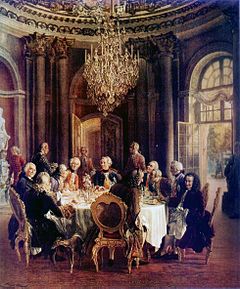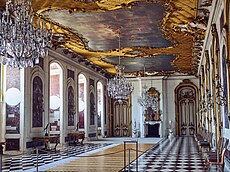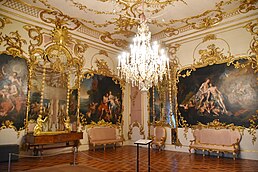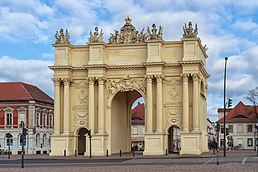Frederician Rococo
Friderizian rococo refers to a form of rococo that originated in Prussia during the reign of Frederick the Great (1740–1786).

Watched by Frederick II. In the middle, leading Voltaire (second chair to the left of the King) a conversation with the sitting opposite Algarotti , between the king and Algarotti sitting Casanova , front right La Mettrie . Oil painting by Adolph von Menzel , 1850.
Works

Well-known early buildings of the Frederician Rococo are Rheinsberg Palace (1736–1740) and, immediately after Frederick II's accession to the throne in 1740, the new wing of Charlottenburg Palace and (until 1751) parts of the Potsdam City Palace , especially its interior fittings, which have now largely been lost. Coinciding with the latter emerged from 1745 Sanssouci Palace , later supplemented by the Picture Gallery and the New Chambers (u. A. And numerous park buildings Chinese House , friendship temple , Ancient temple , obelisk portal , Ruinenberg , Belvedere on the Klausberg ) and to top last 1763-69 the New Palace with his communs . In Potsdam also the Old Town Hall , the Barberini Palace , the Brandenburg Gate and the Nauen Gate and the Marstall .
In Berlin, the Forum Fridericianum was built between 1740 and 1786 , consisting of the State Opera Unter den Linden , the Palais of Prince Heinrich , the St. Hedwig's Church and the Old Library . The Gendarmenmarkt , which was laid out in 1688, was rebuilt from 1773 with new houses and a French comedy house and from 1780–1785 with the classicist towers of the German and French cathedral .
Mention should also be made of the (1751–1753 redesigned) Breslau City Palace . Artists from the court were also active on behalf of the nobility, for example at various Berlin and Potsdam palaces or at the Groß Kreutz manor and also at town houses.
Artist
The most important master builder was the autodidactic “cavalier architect” Georg Wenzeslaus von Knobelsdorff ; Friedrich Wilhelm Diterichs , the creator of the terraces of Sanssouci and a student of Andreas Schlueter , was one of his employees . King Friedrich himself also influenced Knobelsdorff's designs. Furthermore, Johann Gottfried Büring and Carl Ludwig Hildebrandt to name who participated in the construction of Sanssouci, the New Palace and the palace of Potsdam; With the Nauener Tor in 1754/55, Büring created Germany's first neo-Gothic building. Heinrich Ludwig Manger and Carl von Gontard completed the New Palais. Gontard and Georg Christian Unger built the towers of the German and French Cathedral on Berlin's Gendarmenmarkt and the Brandenburg Gate in Potsdam, while Jan Bouman built the Berlin Palais of Prince Heinrich and the Potsdam Old Town Hall. The late Frederician Rococo style found another grandiose climax with the New Palace and the interior of the New Chambers, although early Classicism largely determined the taste of the time, for example at the Wörlitz Castle at the same time . With the cathedral towers on Gendarmenmarkt, Friedrich himself also paid tribute to the new style; his successor was to help classicism a few years later - with Gontard's marble palace - also to make its breakthrough in Prussia; with Carl Gotthard Langhans , who began in Rheinsberg in the Rococo style, and David Gilly and Michael Philipp Boumann , he then found his own expression.
Antoine Pesne was one of the preferred painters, his student Bernhard Rode created wall and ceiling paintings, as did Carl Friedrich Fechhelm , in the late period Johann Christoph Frisch . "Surintendent des ornements" was initially the sculptor Johann August Nahl , until his escape in 1746. French artists were also temporarily employed, such as Charles-Amédée-Philippe van Loo , Jean Laurent Legeay or the Berlin flower and fruit painter Augustin Dubuisson.
The sculptors were Johann Peter Benkert , Johann Mathias Gottlieb Heymüller , Benjamin Giese , Friedrich Christian Glume , the brothers Johann David Räntz and Johann Lorenz Räntz . Furniture and doors were made by the brothers Johann Michael Hoppenhaupt the Elder and Johann Christian Hoppenhaupt the Younger from Saxony, as well as the Bayreuth brothers Heinrich Wilhelm Spindler and Johann Friedrich Spindler . The Swiss Johann Melchior Kambly made bronzes, and stucco work in the late period by Constantin Philipp Georg Sartori . The artists and products of the Königliche Porzellan-Manufaktur Berlin, founded in 1763, also played an important role .
photos
Jasper Hall of the New Chambers
Charlottenburg Palace , "Knobelsdorff Wing"
Potsdam City Palace , Marble Hall
literature
- Hans-Joachim Giersberg , Hillert Ibbeken : Sanssouci Palace. The summer residence of Frederick the Great. With contributions by Thomas Blisniewski , Tilo Eggeling, Jürgen Hamel u. a. Nicolai. Berlin 2005, ISBN 3-89479-140-3 .
- Friderizianisches Rococo, in: The great art lexicon by PW Hartmann
- Samuel Wittwer: KPM Shape Use Collect , Volume 221. Keramos, 2013 / III, p. 46.














